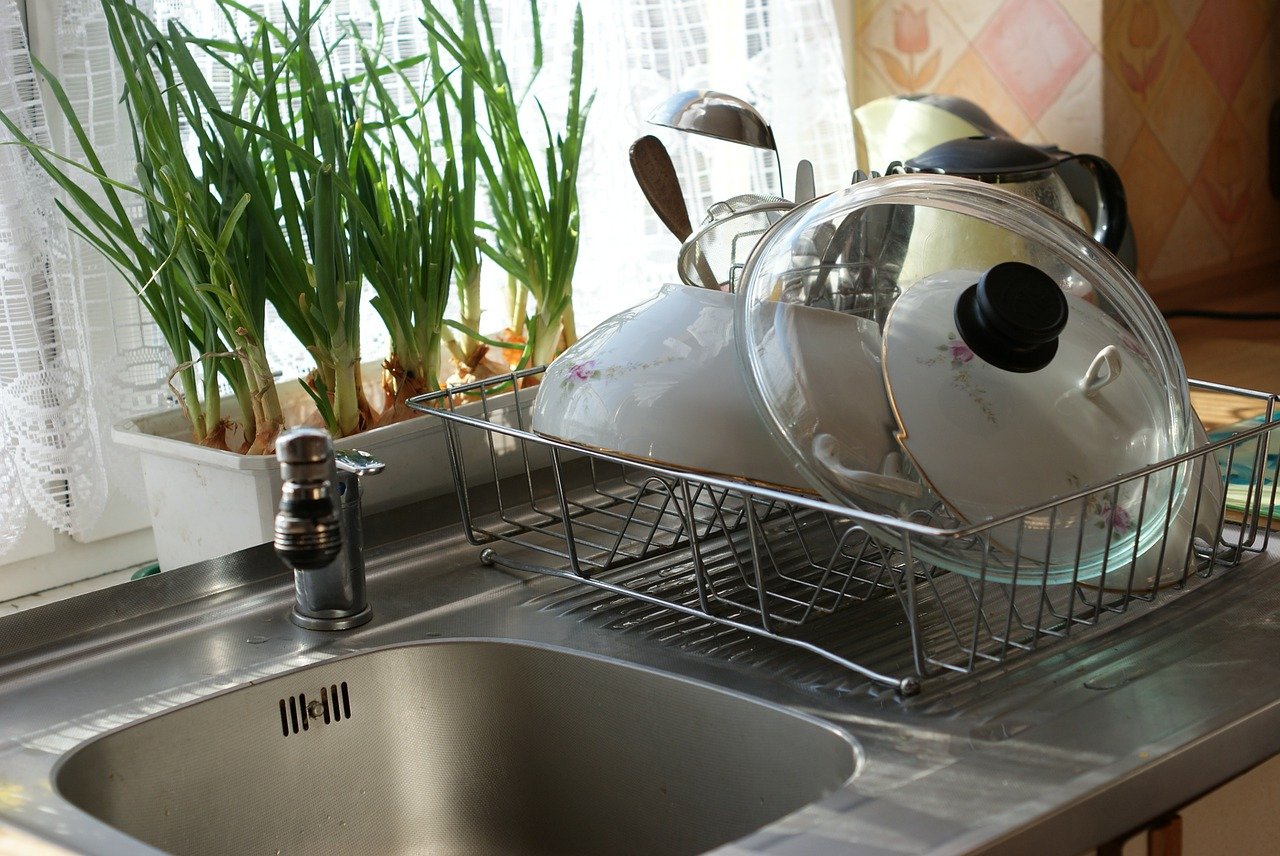In this post we’ll look at some Korean vocabulary and expressions for an important part of everyday life: 부엌 bueok the kitchen. 요리 해요? yori haeyo? Do you cook? No matter how you answer, you probably spend a decent amount of time in the kitchen, so let’s dig in.
접시, 컵, 포크 jeobshi, keob, pokeu Plate, Cups, Forks
Let’s start with the things you use to eat. Of course the basics are: 접시 jeobshi plate, 그릇 geuleut bowl, 칼 kal knife, 수저 sujeo spoon, 포크 pokeu fork, 젓가락 jeotgalag chopsticks, 컵 keob cup, 유리컵 yulikeob glass, 냅킨 naebkin napkin.
- 포크, 칼, 수저가 어디 있어요?
pokeu, kal, sujeoga eodi isseoyo?
Where are the forks, knives, and spoons? - 포크, 칼, 수저는 서랍에 있어요.
pokeu, kal, sujeoneun seolab-e isseoyo.
The forks, knives, and spoons are in the drawer.
- 깨끗한 유리컵은 캐비닛에 있어요.
kkaekkeutan yulikeob-eun kaebinis-e iss-eoyo.
The clean glasses are in the cabinet. - 커피 컵은 선반에 있어요.
keopi keob-eun seonban-e isseoyo.
The coffee cups are on the shelf. - 와인 잔을 깼어요.
wain jan-eul kkaesseoyo.
I broke a wine glass. - 나무 젓가락 아니면 쇠 젓가락을 쓰세요?
namu jeotgalag animyeon soe jeotgalag-eul sseuseyo?
Do you use wooden or metal chopsticks? - 냅킨 좀 주시겠어요?
naebkin jom jusigesseoyo?
Could I have a napkin, please? - 스프를 담을 더 큰 그릇이 있어요?
seupeu-reul dam-eul deo keun geuleush-i isseoyo?
Do you have bigger bowls for the soup? - 깨끗한 접시를 캐비닛에 넣으세요.
kkaekkeutan jeobshileul kaebinis-e neoheuseyo.
Please put the clean plates in the cabinet.
주방기기 jubang-gigi Kitchen Appliances
Even if you don’t have a lot of gadgets in your kitchen, you’ve probably got most of these: 냉장고 naengjanggo a refrigerator, 스토브 / 가스 레인지 seutobeu / gaseu reinji a stove/gas range, 오븐 obeun an oven, 전자레인지 jeonjaleinji a microwave oven, 토스터 toseuteo a toaster, 싱크대 shingkeudae a sink, 식기세척기 shiggisecheoggi a dishwasher.
- 우유는 냉장고에 있어요.
uyu-neun naengjanggo-e isseoyo.
The milk is in the refrigerator. - 냉장고 문을 닫아 주세요.
naengjanggo mun-eul dada juseyo.
Close the refrigerator door please! - 스토브에서 스프를 요리해요.
seutobeu-eseo seupeu-leul yolihaeyo.
I cook soup on the stove. - 오븐에서 케익과 빵을 구워요.
obeun-eseo keiggwa ppang-eul guwoyo.
I bake cakes and bread in the oven. - 남은 음식을 전자렌지에 데운다.
nam-eun eumsig-eul jeonjalenji-e deunda.
I reheat leftovers in the microwave. - 토스터기에서 토스트를 만든다.
toseuteogi-eseo toseuteu-leul mandeunda.
I make toast in the toaster. - 더러운 그릇들은 싱크대에 있어요.
deoleoun geuleusdeul-eun shingkeudae-e isseoyo.
The dirty dishes are in the sink. - 식기 세척기를 비워야 해요.
shiggi secheoggi-leul biwoya haeyo.
I need to empty the dishwasher.
And depending on where you live and what you like to eat, there’s also: 밥솥 babsot a rice maker, 커피 메이커 keopi meikeo a coffee maker, 전기 주전자 jeongi jujeonja an electric kettle, 슬로우쿠커 seulloukukeo a slow cooker, 에어 프라이어 eeo peulaieo an air fryer, 빵 기계 ppang gigye a bread machine, 아이스크림 기계 aiseukeulim gigye an ice-cream maker, 딥 프라이어 dib peulaieo a deep fryer.
- (나는) 언제나 밥솥을 이용해요.
(na-neun) eonjena babsot-eul iyonghaeyo.
I always use a rice cooker. - (나는) 밥을 스토브에서 하지 않아요.
(na-neun) bab-eul seutobeu-eseo haji anayo.
I never cook rice on the stove. - (우리는) 새 커피메이커가 필요해요.
(uli-neun) sae keopimeikeo-ga pilyo haeyo.
We need a new coffee maker. - 전기 주전자에 물을 끓여요.
jeongi jujeonja-e mul-eul kkeulyeoyo.
I boil water in the electric kettle. - 슬로우쿠커를 자주 사용해요?
seulloukukeo-leul jaju sayonghaeyo?
Do you use your slow cooker often? - 에어 프라이어는 많은 기름을 사용하지 않아요.
eeo peulaieo-neun man-eun gileum-eul sayonghaji anayo.
Air friers don’t use a lot of oil. - 빵 기계에서 빵을 만들어요.
ppang gigye-eseo ppang-eul mandeul-eoyo.
I make bread in the bread maker. - 생일선물로 아이스크림 메이커를 받았어요.
saeng-ilseonmul-lo aiseukeulim meikeo-leul badasseoyo.
I got an ice cream maker for my birthday. - 딥 프라이어는 많은 기름을 사용해요.
dib peulaieo-neun man-eun gileum-eul sayonghaeyo.
Deep friers use a lot of oil.
도마와 믹싱볼 domawa migsingbol Cutting boards and Mixing Bowls
No matter how much you cook, you probably have at least a few of these: 도마 doma a cutting board, 칼세트 kalseteu a set of knives, 믹싱볼 migsingbol a mixing bowl, 나무 숟가락 namu sudgalag a wooden spoon, 국자 gugja a ladle, 식품 가공기 shigpum gagonggi (푸드 프로세서는 pudeu peuloseseo) a food processor, 전기 믹서기 jeongi migseogi an electric mixer, 웍 wog a wok, 베이킹 시트 beiking shiteu a baking sheet, 베이킹팬 beikingpaen a baking pan, 프라이팬 peulaipaen a frying pan, 냄비 naembi a pot.
- 도마에서 야채를 잘라요.
doma-eseo yachae-leul jallayo.
I cut vegetables on a cutting board. - 카운터에는 공간이 없어요.
kaunteo-e-neun gonggan-i eobseoyo.
There’s no space on the counter. - 잘드는 칼 세트가 있어요?
jaldeuneun kal seteu-ga isseoyo?
Do you have a set of sharp knives? - 재료들을 믹싱볼에서 섞어요.
jaelyodeul-eul migsingbol-eseo seokkeoyo.
I mix ingredients in a mixing bowl. - 나무 숟가락으로 스프를 저어요.
namu sudgalag-eulo seupeu-leul jeoeoyo.
I stir soup with a wooden spoon. - 국을 줄 때 국자를 이용해요.
gug-eul jul ttae gugja-leul iyonghaeyo.
I use a ladle to serve soup. - 푸드 프로세서는 빠르고 편리해요.
pudeu peuloseseo-neun ppaleugo pyeonlihaeyo.
Food processors are fast and convenient. - 전기 믹서기를 자주 사용해요?
jeongi migseogi-leul jaju sayonghaeyo?
Do you use the electric mixer often? - 쿠키가 베이킹 시트에 있어요.
kuki-ga beiking siteu-e isseoyo.
The cookies are on the baking sheet. - 생선을 베이킹팬에 요리해요.
saengseon-eul beikingpaen-e yolihaeyo.
I cook fish in a baking pan. - 웍을 자주 사용해요.
wog-eul jaju sayonghaeyo.
I use the wok very often. - 계란을 프라이팬에 요리해요.
gyelan-eul peulaipaen-e yolihaeyo.
I cook eggs in a frying pan. - 스프를 넣을 큰 냄비가 있어요?
seupeu-leul neo-eul keun naembi-ga iss-eoyo?
Do you have a large pot for the soup?
저녁을 만들어요. jeonyeog-eul mandeul-eoyo. I’m Making Dinner
If you’re looking for vocabulary and expressions related to cooking, check out this post. And here’s a bunch of food vocabulary that will come in handy when you’re talking about eating or cooking:
- 빵 ppang bread
- 쌀 ssal, 밥 bab rice
- 파스타 paseuta pasta
- 국수gugsu noodles
- 고기 gogi meat
- 닭 dag chicken
- 소고기 sogogi beef
- 돼지고기dwaejigogi pork
- 햄 haem ham
- 생선 saengseon fish
- 양고기 yanggogi lamb
- 두부 dubu tofu
- 채소 chaeso vegetables
- 토마토 tomato tomato
- 양파 yangpa onion
- 마늘 maneul garlic
- 상추 sangchu lettuce
- 시금치 shigeumchi spinach
- 아스파라거스aseupalageoseu asparagus
- 양배추 yangbaechu cabbage
- 버섯 beoseot mushroom
- 오이 oi cucumber
- 피망 pimang pepper (as in bell)
- 고춧가루 gochugaru chili pepper
- 과일 gwail fruit
- 사과 sagwa apple
- 배 bae pear
- 복숭아 bogsunga peach
- 오렌지 oraenji orange
- 레몬 raemon lemon
- 포도 podo grape
- 딸기 ddalgi strawberry
- 바나나 banana banana
- 견과 gyeongwa nut
- 땅콩 ddangkong peanut
- 씨 sshi seed
- 밀 mil wheat
- 시리얼 shirieol cereal
- 소금 sogeum salt
- 후추 hocha pepper
- 참깨 chamkkae sesame
- 꿀 kkul honey
- 설탕 seoltang sugar
- 계란 gyeran egg
- 우유 uyu milk
- 물 mul water
- 차 cha tea
- 커피 keopi coffee
- 와인 wain wine
- 맥주 maekju beer
- 두유 doyu soy milk
- 간장 ganchang soy sauce
- 치즈 chiseu cheese
- 아이스크림 aiseukeurim ice cream
- 케이크 keikeu cake
- 파이 pai pie
- 쿠키 kuki cookie
- 사탕 satang candy
- 먹다 meogda to eat
- 마시다 mashida to drink
- 요리하다 yorihada to cook
- 맛보다 matboda to taste
용기, 병, 봉지 yonggi, byeong, bongji Containers, Jars, and Bags
Different foods are stored in different types of containers, so may want to say:
- 파스타/쿠키/시리얼 한 박스
paseuta/kuki/silieol han bagseu
a box of pasta/cookies/cereal - 감자/냉동 야채 한 봉지
gamja/naengdong yachae han bongji
a bag of potatoes/frozen vegetables - 물/와인 한 병
mul/wain han byeong
a bottle of water/wine - 우유/주스 한 통
uyu/juseu han tong
a carton of milk/juice - 콩/참치/스프 한 캔
kong/chamchi/seupeu han kaen
a can of beans/tuna/soup - 올리브/피클/과일 잼 한 병
ollibeu/pikeul/gwail jaem han byeong
a jar of olives/pickles/fruit preserves - 케찹/ 마요네즈 한 병
kechab/ mayonejeu han byeong
a container of ketchup/mayonnaise - 닭/두부 한 패키지
dag/dubu han paekiji
a package of chicken/tofu
부엌이 깨끗해요! bueok-i kkaekkeushaeyo! The kitchen is clean!
Even if you don’t use it much, the kitchen always seems to need cleaning. And there’s a whole set of vocabulary that you can use to talk about that: 빗자루 bitjalu a broom, 대걸레 daegeolle a mop, 스폰지 seuponji a sponge, 주방세제 jubangseje dish detergent, 행주 haengju a dishtowel, 유리 세정제 yuli sejeongje a glass cleaner, 페이퍼타올 peipeotaol a paper towel, 물통 multong a bucket, 바닥 청소제 badag cheongsoje floor cleaner, 쓰레기통 sseulegitong trash can/bin.
- 설거지를 해야 해요.
seolgeoji-leul haeya haeyo.
I need to do the dishes. - (우리는) 주방세제를 사야 해요.
(uli-neun) jubangseje-leul saya haeyo.
We need to buy dish detergent. - 설거지 할 때 스폰지와 식기 수건을 사용해요.
seolgeoji hal ttae seuponjiwa siggi sugeon-eul sayonghaeyo.
I use a sponge and a dishtowel to do the dishes. - 빗자루로 바닥을 쓸어요.
bisjalu-lo badag-eul sseuleoyo.
I sweep the floor with a broom. - 바닥이 더러우면 대걸레로 닦아요.
badag-i deoleoumyeon daegeolle-lo dakkayo.
I mop the floor when it’s dirty. - 종이 타월과 스프레이 세정제로 카운터를 닦아요.
jong-i tawolgwa seupeulei sejeongje-lo kaunteo-leul dakkayo.
I wipe the counter with a paper towel and a spray cleaner. - 바닥 청소제와 따뜻한 물을 양동이에 담아요.
badag cheongsojewa ttatteushan mul-eul yangdongi-e damayo.
I put floor cleaner and warm water in the bucket. - 쓰레기통을 비워야 해요.
sseulegitong-eul biwoya haeyo.
I need to take out the trash. - 쓰레기통 냄새가 안좋아요!
sseulegitong naemsae-ga anjohayo!
The trashcan smells bad!
Learn Korean with the Language Garage
Check out our other posts on Korean language, culture, and more. And if you’re looking for convenient and affordable live Korean lessons with a real teacher, check out The Language Garage. Our lessons are given online in a virtual classroom, so it doesn’t matter where you live or work – we can come to you. And we have flexible options, with a free trial so that you can decide if there’s a fit. Check us out!






